Abstract
1. The ventilatory response to isoxic square-wave challenges in end-tidal PCO2 was investigated at three levels of end-tidal PO2 (PET, O2) in nine healthy male subjects. 2. Twenty-seven responses against a background of mild hypoxia (PET, O2 approximately 10 kPa), sixty-seven against a background of normoxia (PET, O2 approximately 14.5 kPa) and seventy-six against a background of hyperoxia (PET, O2 approximately 70 kPa) were collected. 3. The breath-to-breath data were partitioned into a fast and a slow ventilatory component using a two-compartment model. 4. In the normoxic and hypoxic experiments the CO2 sensitivity of the fast component averaged to about 30 and 40% of the total CO2 sensitivity, respectively. In the hyperoxic experiments three subjects had no fast component in their response while in three others the CO2 sensitivity of the fast component averaged to about 24% of the total CO2 sensitivity. In the remaining three subjects the presence of a fast component was doubtful. 5. We argue that the fast component is due to the peripheral chemoreflex loop and the slow component to the central chemoreflex loop. 6. The central CO2 sensitivity and the apnoeic threshold (extrapolated end-tidal CO2 at zero ventilation in the steady state) were 15% smaller in hyperoxia than those in normoxia and hypoxia. In normoxia and mild hypoxia the central CO2 sensitivities were not significantly different. 7. We argue, that apart from peripheral oxygen-carbon dioxide interaction, there is evidence for central oxygen-carbon dioxide interaction in human subjects. 8. We conclude that in general there is a contribution to ventilation of the peripheral chemoreceptors during hyperoxia in man.
Full text
PDF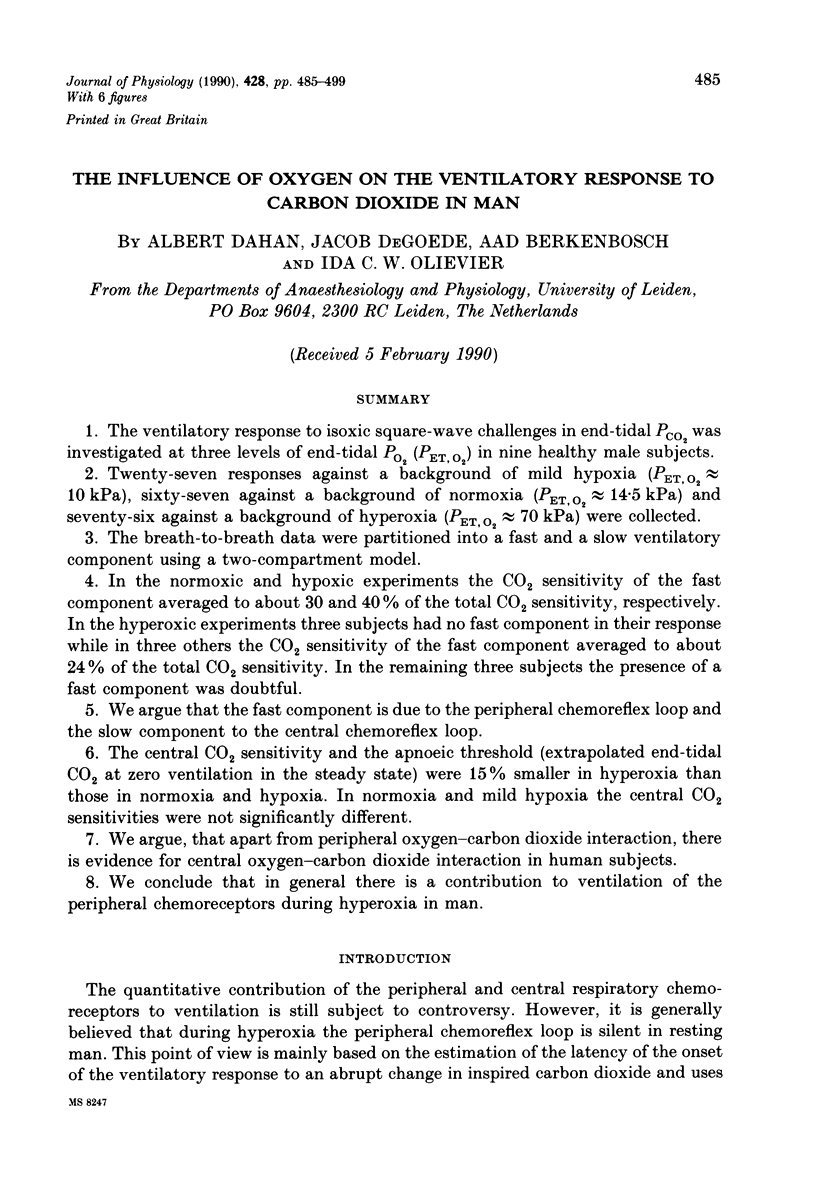


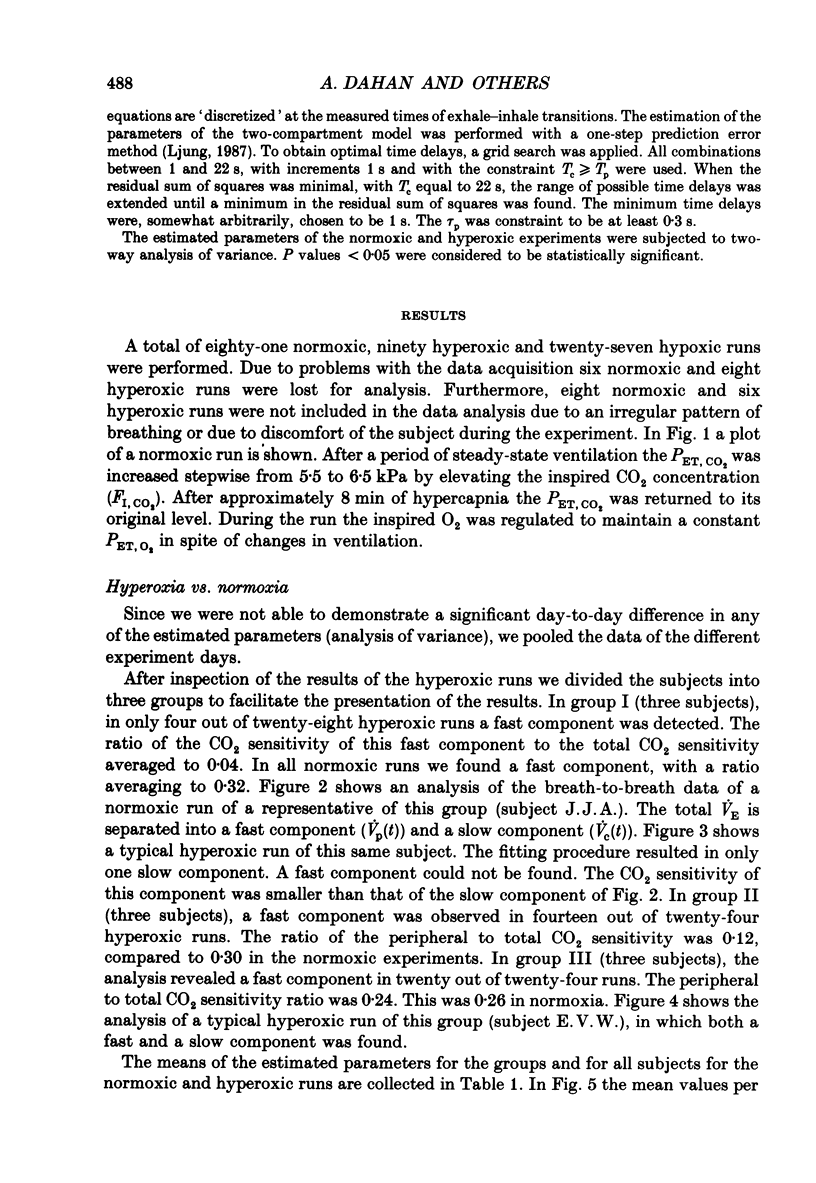


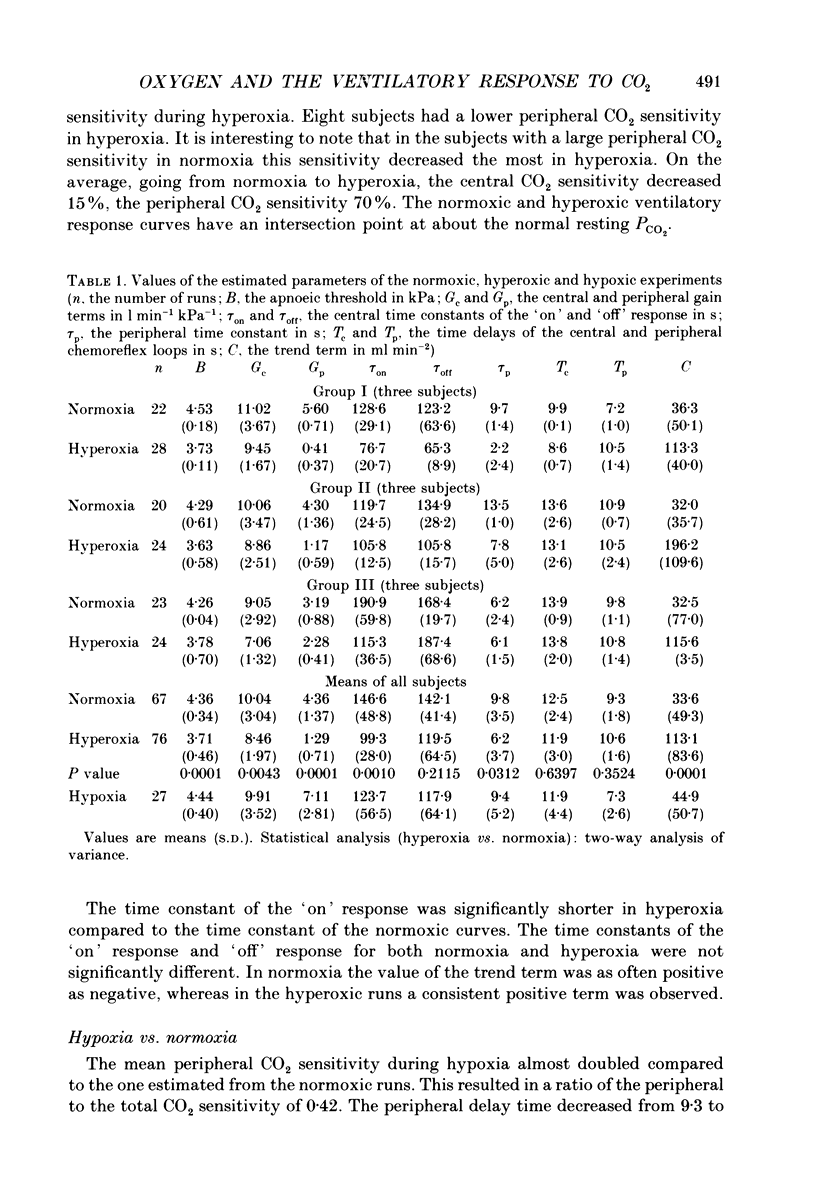
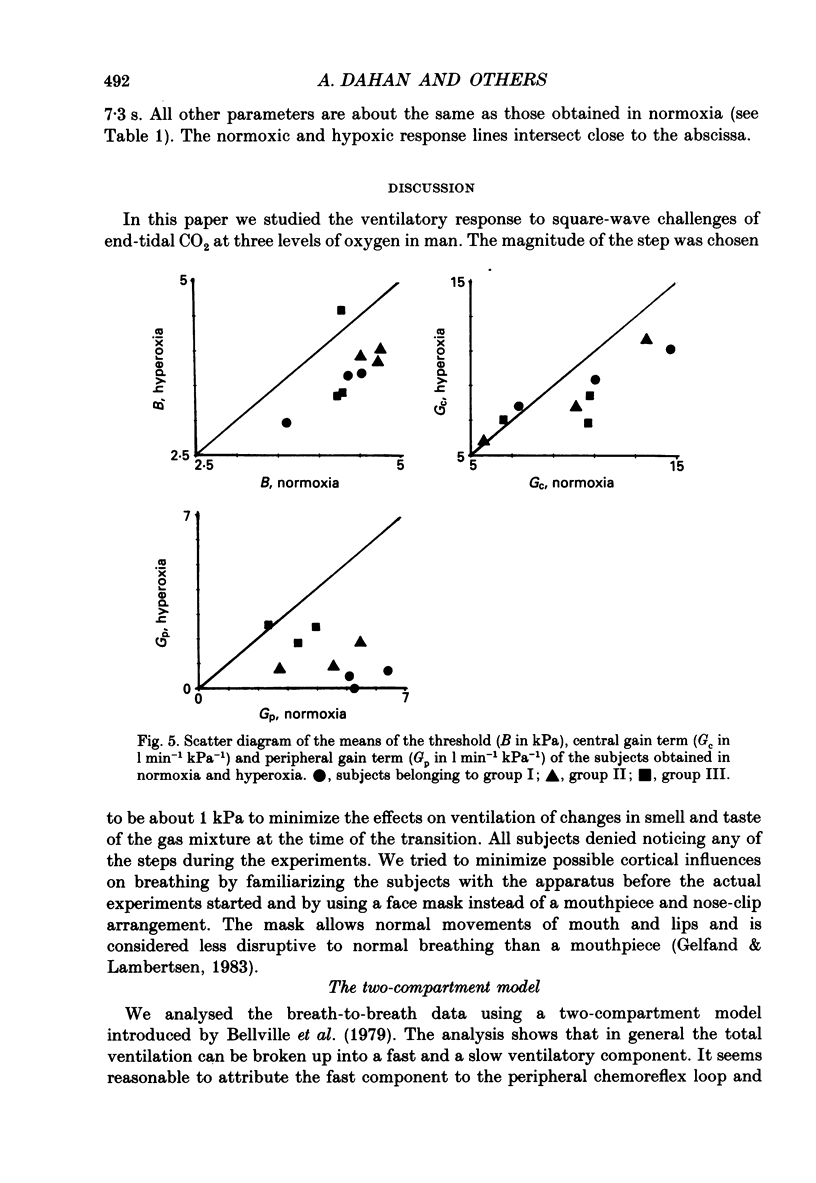
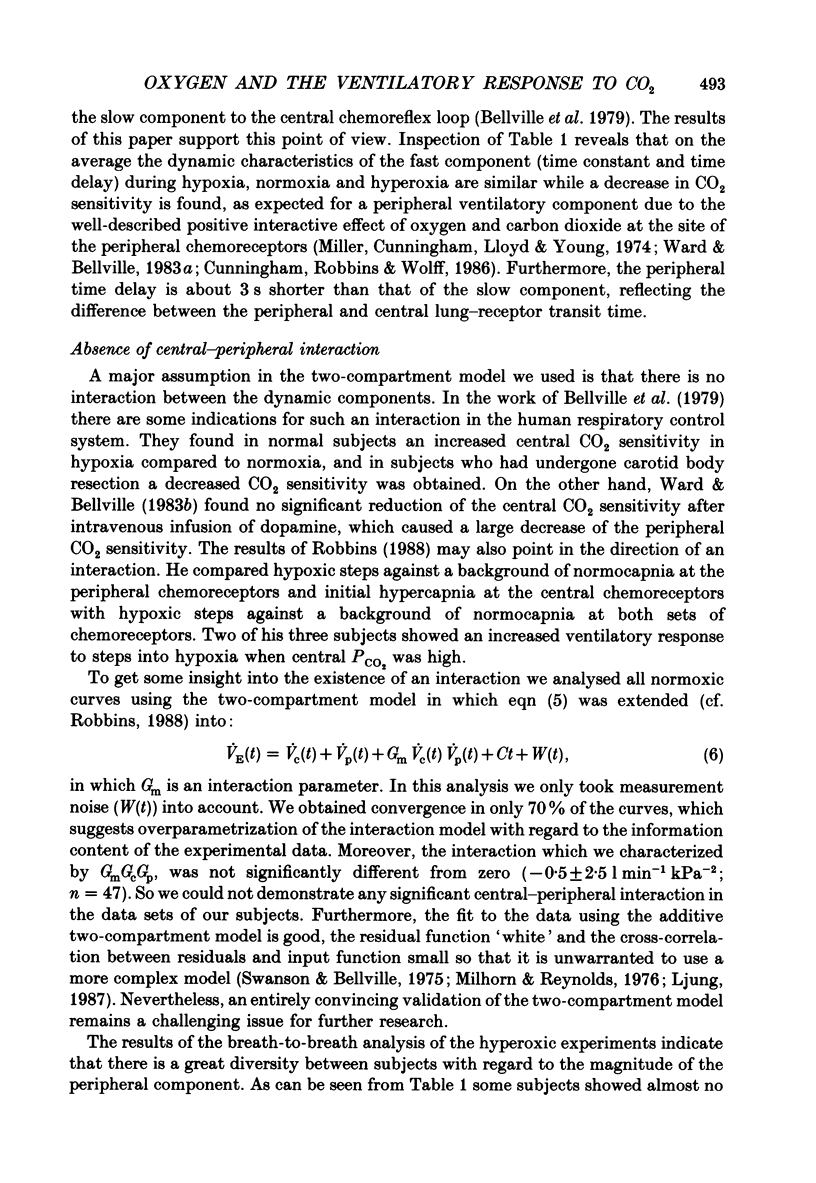

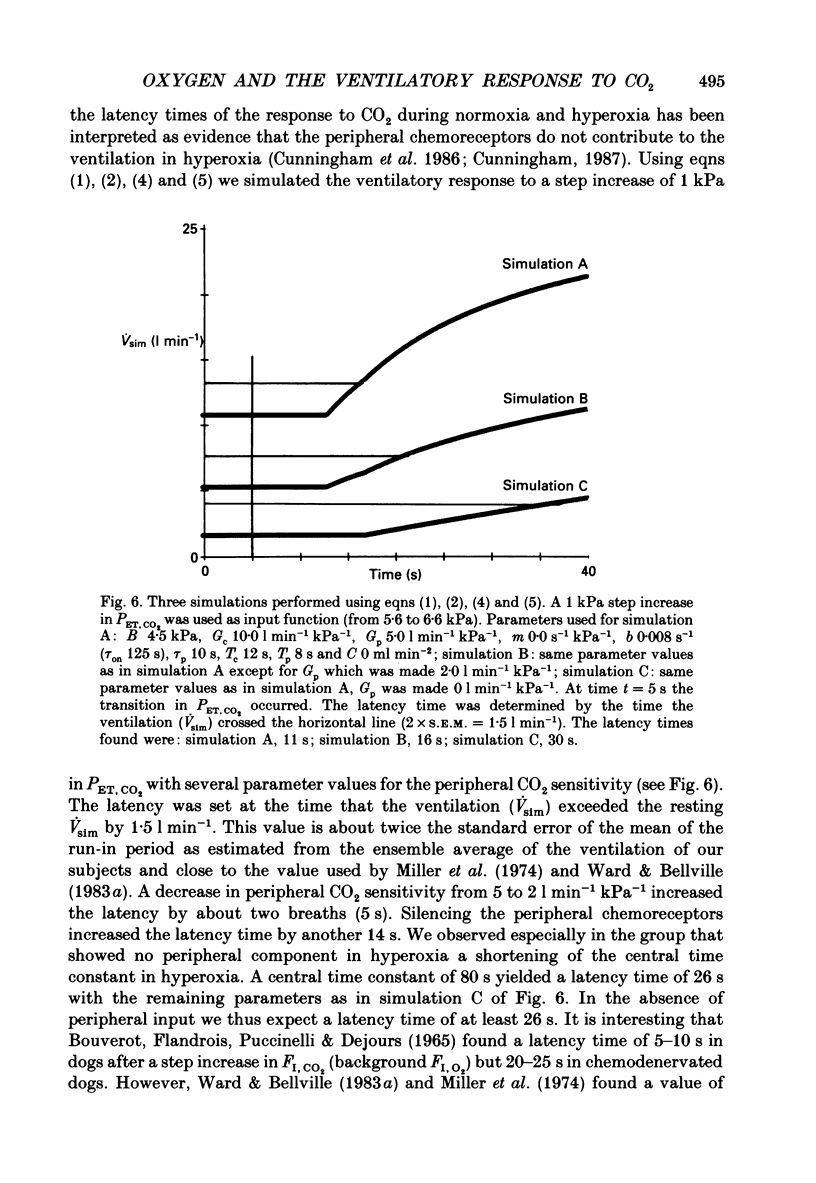


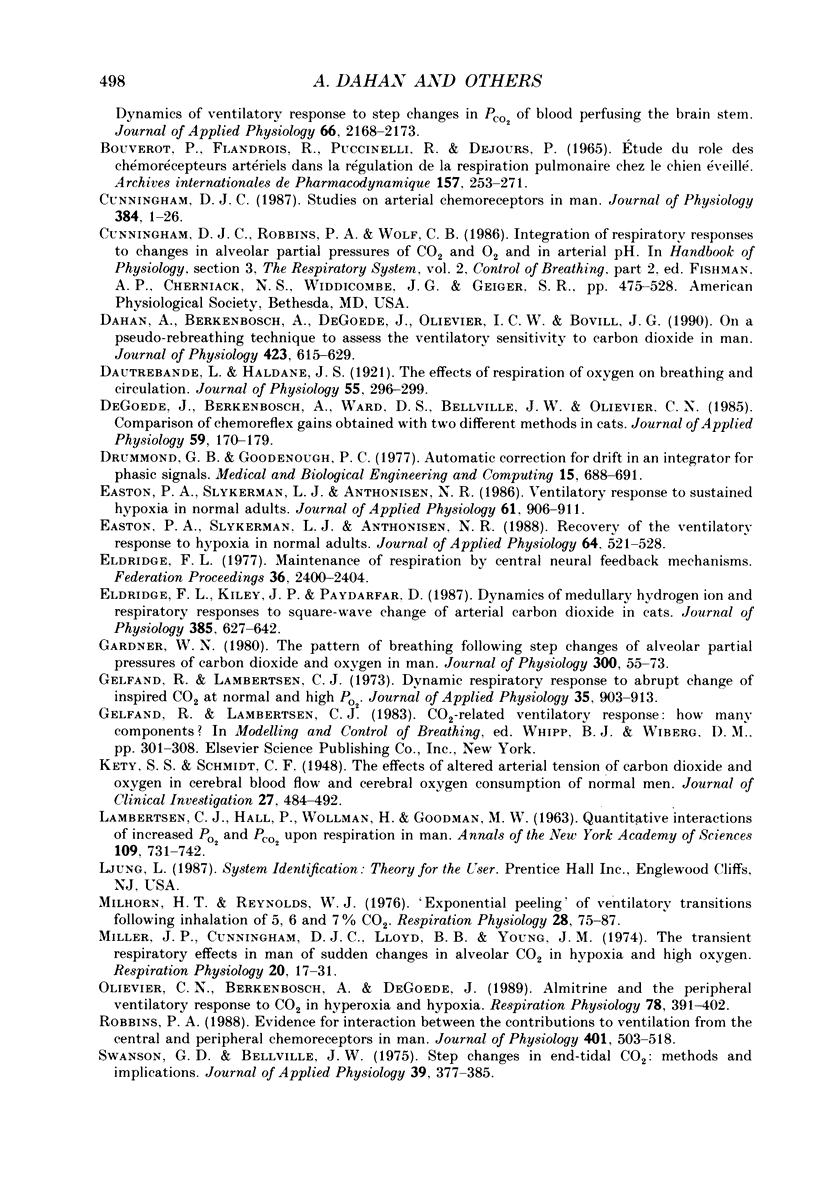

Selected References
These references are in PubMed. This may not be the complete list of references from this article.
- Bellville J. W., Whipp B. J., Kaufman R. D., Swanson G. D., Aqleh K. A., Wiberg D. M. Central and peripheral chemoreflex loop gain in normal and carotid body-resected subjects. J Appl Physiol Respir Environ Exerc Physiol. 1979 Apr;46(4):843–853. doi: 10.1152/jappl.1979.46.4.843. [DOI] [PubMed] [Google Scholar]
- Berger A. J., Krasney J. A., Dutton R. E. Respiratory recovery from CO 2 breathing in intact and chemodenervated awake dogs. J Appl Physiol. 1973 Jul;35(1):35–41. doi: 10.1152/jappl.1973.35.1.35. [DOI] [PubMed] [Google Scholar]
- Berkenbosch A., Ward D. S., Olievier C. N., DeGoede J., VanHartevelt J. Dynamics of ventilatory response to step changes in PCO2 of blood perfusing the brain stem. J Appl Physiol (1985) 1989 May;66(5):2168–2173. doi: 10.1152/jappl.1989.66.5.2168. [DOI] [PubMed] [Google Scholar]
- Bouverot P., Flandrois R., Puccinelli R., Dejours P. Etude du role des chémorécepteurs artériels dans la régulation de la respiration pulmonaire chez le chien éveillé. Arch Int Pharmacodyn Ther. 1965 Oct;157(2):253–271. [PubMed] [Google Scholar]
- Cunningham D. J. Studies on arterial chemoreceptors in man. J Physiol. 1987 Mar;384:1–26. doi: 10.1113/jphysiol.1987.sp016440. [DOI] [PMC free article] [PubMed] [Google Scholar]
- Dahan A., Berkenbosch A., DeGoede J., Olievier I. C., Bovill J. G. On a pseudo-rebreathing technique to assess the ventilatory sensitivity to carbon dioxide in man. J Physiol. 1990 Apr;423:615–629. doi: 10.1113/jphysiol.1990.sp018043. [DOI] [PMC free article] [PubMed] [Google Scholar]
- Dautrebande L., Haldane J. S. The effects of respiration of oxygen on breathing and circulation. J Physiol. 1921 Aug 3;55(3-4):296–299. doi: 10.1113/jphysiol.1921.sp001972. [DOI] [PMC free article] [PubMed] [Google Scholar]
- DeGoede J., Berkenbosch A., Ward D. S., Bellville J. W., Olievier C. N. Comparison of chemoreflex gains obtained with two different methods in cats. J Appl Physiol (1985) 1985 Jul;59(1):170–179. doi: 10.1152/jappl.1985.59.1.170. [DOI] [PubMed] [Google Scholar]
- Drummond G. B., Goodenough P. C. Automatic correction for drift in an integrator for phasic signals. Med Biol Eng Comput. 1977 Nov;15(6):688–691. doi: 10.1007/BF02457928. [DOI] [PubMed] [Google Scholar]
- Easton P. A., Slykerman L. J., Anthonisen N. R. Recovery of the ventilatory response to hypoxia in normal adults. J Appl Physiol (1985) 1988 Feb;64(2):521–528. doi: 10.1152/jappl.1988.64.2.521. [DOI] [PubMed] [Google Scholar]
- Easton P. A., Slykerman L. J., Anthonisen N. R. Ventilatory response to sustained hypoxia in normal adults. J Appl Physiol (1985) 1986 Sep;61(3):906–911. doi: 10.1152/jappl.1986.61.3.906. [DOI] [PubMed] [Google Scholar]
- Eldridge F. L., Kiley J. P., Paydarfar D. Dynamics of medullary hydrogen ion and respiratory responses to square-wave change of arterial carbon dioxide in cats. J Physiol. 1987 Apr;385:627–642. doi: 10.1113/jphysiol.1987.sp016511. [DOI] [PMC free article] [PubMed] [Google Scholar]
- Eldridge F. L. Maintenance of respiration by central neural feedback mechanisms. Fed Proc. 1977 Sep;36(10):2400–2404. [PubMed] [Google Scholar]
- Gardner W. N. The pattern of breathing following step changes of alveolar partial pressures of carbon dioxide and oxygen in man. J Physiol. 1980 Mar;300:55–73. doi: 10.1113/jphysiol.1980.sp013151. [DOI] [PMC free article] [PubMed] [Google Scholar]
- Gelfand R., Lambertsen C. J. Dynamic respiratory response to abrupt change of inspired CO2 at normal and high PO2. J Appl Physiol. 1973 Dec;35(6):903–913. doi: 10.1152/jappl.1973.35.6.903. [DOI] [PubMed] [Google Scholar]
- Kety S. S., Schmidt C. F. THE EFFECTS OF ALTERED ARTERIAL TENSIONS OF CARBON DIOXIDE AND OXYGEN ON CEREBRAL BLOOD FLOW AND CEREBRAL OXYGEN CONSUMPTION OF NORMAL YOUNG MEN. J Clin Invest. 1948 Jul;27(4):484–492. doi: 10.1172/JCI101995. [DOI] [PMC free article] [PubMed] [Google Scholar]
- LAMBERTSEN C. J., HALL P., WOLLMAN H., GOODMAN M. W. Quantitative interactions of increased Po2 and Pco2 upon respiration in man. Ann N Y Acad Sci. 1963 Jun 24;109:731–742. doi: 10.1111/j.1749-6632.1963.tb13502.x. [DOI] [PubMed] [Google Scholar]
- Milhorn H. T., Jr, Reynolds W. J. 'Exponential peeling' of ventilatory transients following inhalation of 5, 6 and 7% CO2. Respir Physiol. 1976 Oct;28(1):75–87. doi: 10.1016/0034-5687(76)90086-4. [DOI] [PubMed] [Google Scholar]
- Miller J. P., Cunningham D. J., Lloyd B. B., Young J. M. The transient respiratory effects in man of sudden changes in alveolar CO2 in hypoxia and in high oxygen. Respir Physiol. 1974 Feb;20(1):17–31. doi: 10.1016/0034-5687(74)90015-2. [DOI] [PubMed] [Google Scholar]
- Olievier C. N., Berkenbosch A., DeGoede J. Almitrine and the peripheral ventilatory response to CO2 in hyperoxia and hypoxia. Respir Physiol. 1989 Dec;78(3):391–402. doi: 10.1016/0034-5687(89)90113-8. [DOI] [PubMed] [Google Scholar]
- Robbins P. A. Evidence for interaction between the contributions to ventilation from the central and peripheral chemoreceptors in man. J Physiol. 1988 Jul;401:503–518. doi: 10.1113/jphysiol.1988.sp017175. [DOI] [PMC free article] [PubMed] [Google Scholar]
- Swanson G. D., Bellville J. W. Step changes in end-tidal CO2: methods and implications. J Appl Physiol. 1975 Sep;39(3):377–385. doi: 10.1152/jappl.1975.39.3.377. [DOI] [PubMed] [Google Scholar]
- Teppema L. J., Vis A., Evers J. A., Folgering H. T. Dynamics of brain extracellular fluid pH and phrenic nerve activity in cats after end-tidal CO2 forcing. Respir Physiol. 1982 Dec;50(3):359–380. doi: 10.1016/0034-5687(82)90029-9. [DOI] [PubMed] [Google Scholar]
- Ward D. S., Bellville J. W. Effect of intravenous dopamine on hypercapnic ventilatory response in humans. J Appl Physiol Respir Environ Exerc Physiol. 1983 Nov;55(5):1418–1425. doi: 10.1152/jappl.1983.55.5.1418. [DOI] [PubMed] [Google Scholar]
- van Beek J. H., Berkenbosch A., de Goede J., Olievier C. N. Influence of peripheral O2 tension on the ventilatory response to CO2 in cats. Respir Physiol. 1983 Mar;51(3):379–390. doi: 10.1016/0034-5687(83)90030-0. [DOI] [PubMed] [Google Scholar]


